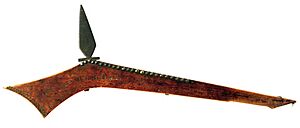Gunstock war club facts for kids
The gunstock club is a special weapon used by many Native American tribes. It gets its name because it looks a lot like the wooden part of old muskets and rifles. These clubs were mostly used by tribes in the Eastern Woodlands, Central Plains, and Northern Plains during the 1700s and 1800s.

A Look at Its History
Historians don't know all the details about how the gunstock club first started. People began using them in the late 1600s. By the mid-1800s, tribes like the Lakota in the Northern Plains were using them a lot.
Where Did the Idea Come From?
Many people thought that Native American tribes copied the design from European guns. When tribes met British, French, and colonial soldiers, they saw how soldiers could use a musket as a powerful hitting weapon in close fights after it had been fired.
Some historians also thought that tribes got real muskets from traders and changed them into clubs. But a club made from a real musket wouldn't last long. It would have holes where the gun's parts were, making it weak. Also, old war clubs found by archaeologists don't show any signs that they were once real firearms. They are often flat and board-like, without places for gun parts.
Another idea is that European muskets and rifles simply gave Native Americans the idea for the gunstock club's shape. The designers might have wanted to use the fear that European muskets caused. By carrying clubs that looked like muskets, Native American tribes might have gained a mental edge over other tribes in battle.
A third idea is that the gunstock war club's design is just a coincidence. Some historians and Native American groups believe it was developed independently, years before Europeans arrived.
How They Were Made
The gunstock club was a very important weapon in tribal warfare. It was good at causing strong hits, like other weapons such as ball-head clubs and stone tomahawks.
These war clubs were usually made from strong hardwoods. These included maple, ash, oak, hickory, or hornbeam, depending on what trees grew in the area. They usually weighed about two to three pounds. The club's design focused the swinging force onto small edges, allowing it to hit with amazing power.
The club became even more dangerous when a short spear point or one or more blades were added near the club's elbow. These blades could be made from flint, horn, or iron. The heart-shaped blade might have been inspired by fancy European pole-arms called spontoons.
When European settlers brought metal knives to Native American tribes, it might have made the gunstock club even more popular. For example, an old Plains Indian gunstock club from the late 1800s was found with three butcher knife blades. These blades were marked with a company name and a patent date from 1860.
The clubs were often decorated with brass tacks. The wood was also carved with geometric shapes or pictures.
Still Used Today
Today, gunstock clubs are still important in Native American society. They are used as part of special outfits for pow wows or for other formal events.
The gunstock war club is also the main weapon used by people who practice Okichitaw. This is a martial art based on the fighting styles of the Assiniboine and Plains Cree Indians. A Canadian martial artist named George J. Lépine recently helped bring this art back to life.

